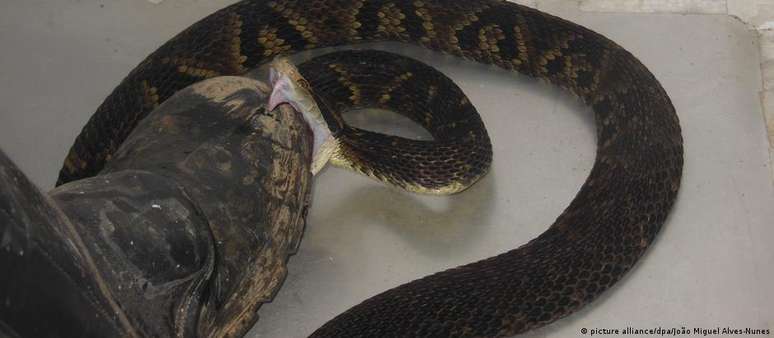A biologist from the Butantan Institute touched vipers more than 40,000 times to find out when and why the venomous snakes bite. The results of the study were published in “Nature”. A researcher from the Butantan Institute in Sao Paulo opted for an unusual method to find out when and why venomous snakes bite: he stepped on or got very close to these animals tens of thousands of times.
Biologist João Miguel Alves Nunes used more than 100 vipers in his research, a species of snake widespread throughout South America and responsible for biting around 20,000 people a year. The results obtained in the study were published in the prestigious scientific journal Nature.
What did the study show?
In an interview with Science magazine, the Brazilian said that until then little research had been carried out on the factors that lead venomous snakes to bite.
Alves Nunes explains that his method of stepping on or getting very close to the animals – with special protective boots – allowed him to disprove the common belief that vipers only bite when touched.
“I got close to the snakes and even slightly above them,” says the researcher. “I didn’t put all my weight on my foot, so I didn’t hurt the snakes. I tested 116 animals and stepped on each animal 30 times, for a total of 40,480 steps.”
According to Alves Nunes, the probability of a viper biting was inversely proportional to its size. In other words, the smaller the animal, the more likely it is to sink its fangs into someone.
According to the study, the female of the species is also more aggressive than the male, especially when young and during the day.
The snakes were even more likely to bite when the weather was warmer, which is when cold-blooded reptiles are more active and have more energy.
According to research, the chances of being bitten also increase if snakes are touched on the head, rather than the central part of the body or the tail.
How important is study?
Alves Nunes says the information gained from the study can help mitigate Brazil’s snakebite problem. “With our new findings, we can predict where bites might occur and better plan antivenom distribution,” he said.
“By combining our data with that of other studies showing the distribution of snakes, we can identify places where animals are more likely to be aggressive. For example, warmer places with a larger population of female snakes should be a priority for antivenom distribution.”
The jararaca is one of the leading causes of bites in the country, accounting for about 90% of visits related to venomous snakes.
Researcher allergic to the antidote
Alves Nunes says he felt “100% safe” when stepping on or approaching snakes because of the boots he was wearing – which he said were chosen based on guidance from expert colleagues at the institute.
However, although the vipers failed to pierce his boots, he was eventually bitten while experimenting with a rattlesnake and had to receive treatment in hospital.
“Fortunately I was in the best place I could be,” the researcher said, referring to the leading institute in the development of anti-venom serums.
But the bite revealed an unfortunate feature for one snake researcher: “Unfortunately, I discovered that I was allergic to both antivenom and snake toxins. I had to take a 15-day medical leave,” he told Science.
On the other hand, demonstrating once again his passion for knowledge at any cost, Alves Nunes transforms misfortune into a good scientific cause.
“Now I’m comparing the bite force of rattlesnakes and pit vipers with the resistance of different materials and shoes to them.”
Source: Terra
Rose James is a Gossipify movie and series reviewer known for her in-depth analysis and unique perspective on the latest releases. With a background in film studies, she provides engaging and informative reviews, and keeps readers up to date with industry trends and emerging talents.







